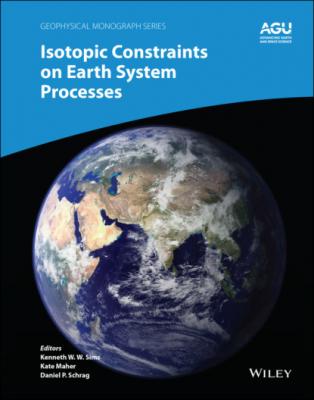Isotopic Constraints on Earth System Processes. Группа авторов
Чтение книги онлайн.
Читать онлайн книгу Isotopic Constraints on Earth System Processes - Группа авторов страница 17
 Molten Rhyolite and Basalt
Molten Rhyolite and Basalt
The type of piston cylinder assembly used by Richter et al. (2003) to determine the isotopic fractionation of calcium and lithium in rhyolite‐basalt diffusion couples is shown schematically in Fig. 1.2.
Fig. 1.3 shows the weight percent of major oxide components measured along five parallel lines along the long dimension of the glass recovered from experiment RB‐2. The data from all five lines fall along common smooth curves that are not symmetric with respect to the original interface between the rhyolite and basalt because the rate of diffusion is much faster in the lower SiO2 content of the basalt side of the couple. The Al2O3 profile is a classic example of uphill diffusion in that the low concentration side of the couple became lower than the initial concentration. This uphill diffusion is an indication that the flux of Al2O3 is dominated by off‐diagonal terms in the diffusion matrix. Except for Al2O3, an effective binary diffusion coefficient D E can be derived from fits to the concentration data of all the other major oxides. Experiment RB‐2 was one of two that were run to determine whether calcium isotopes would become measurably fractionated as calcium diffused from the basalt into the rhyolite.
Figure 1.2 A schematic of the piston cylinder assembly used by Richter et al. (2003) to study isotope fractionation by diffusion between molten rhyolite and basalt.
Fig. 1.4 shows the 44Ca/40Ca fractionation measured by thermal ionization mass spectrometry of purified solutions derived by dissolving thin (~ 0.5 mm) slabs cut perpendicular to the long axis of the recovered glass from experiment RB‐2 run for 15.7 hours at 1450°C and 1.3 GPa, and from a second diffusion couple, RB‐3, run for 12 hours at 1450°C and 1.2 GPa. The calcium isotopic fractionation is reported in the usual per mil notation
The model calculation for the evolution of the major oxide components and the calcium isotopes was formulated using effective binary diffusion coefficients. The conservation equations for total CaO, SiO2, 40CaO, and 44CaO with effective binary diffusion coefficients for CaO and SiO2 that depend on the local SiO2 content of the melt are
Figure 1.3 The panels show the concentration of major oxides measured along five parallel lines perpendicular to the interface between a natural basalt melt (SUNY MORB) and a natural rhyolite melt (Lake County obsidian) that were juxtaposed and annealed in a piston cylinder assembly. The data from each parallel line is plotted with a different symbol, but because the data measured along the five lines are effectively identical, they are not easily distinguished from each other. The fact that the data measured along the parallel lines are indistinguishable shows that diffusion in this couple was perfectly one‐dimensional.
The data plotted in this figure are from Richter et al. (2003).
The initial condition used for the model result shown in Fig. 1.4 was a step function with